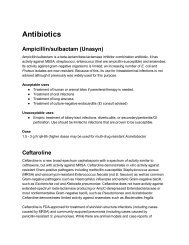Skin and Soft Tissue Infections - UCLA
Skin and Soft Tissue Infections - UCLA
Skin and Soft Tissue Infections - UCLA
Create successful ePaper yourself
Turn your PDF publications into a flip-book with our unique Google optimized e-Paper software.
● Antibiotic therapy should be narrowed based on culture results.<br />
Microbiology<br />
● Cellulitis without open wound or infected ulcer, antibiotic naive: beta-hemolytic<br />
streptococci, S. aureus<br />
● Infected ulcer, chronic or previously treated with antibiotics: S. aureus, beta-hemolytic<br />
streptococci, Enterobacteriaceae<br />
● Exposure to soaking, whirlpool, hot tub: usually polymicrobial, can involve Pseudomonas<br />
● Chronic wounds with prolonged exposure to antibiotics: aerobic gram positive cocci,<br />
diptheroids, Enterobacteriaceae, other gram negative rods including Pseudomonas<br />
● Necrosis or gangrene: mixed aerobic gram positive cocci <strong>and</strong> gram negative rods,<br />
anaerobes<br />
Diagnosis<br />
● Cultures of the ulcer base after debridement can help guide therapy. Avoid swabbing<br />
non-debrided ulcers or wound drainage.<br />
● Ulcer floor should be probed carefully. If bone can be touched with a metal probe then<br />
the patient should be treated for osteomyelitis with antibiotics in addition to possible<br />
surgical debridement.<br />
● A deep foot-space infection can be present. Consider imaging to look for deep<br />
infections.<br />
● Putrid discharge is diagnostic for the presence of anaerobes.<br />
● MRI is more sensitive <strong>and</strong> specific than other rmodalities for detection of soft-tissue<br />
lesions <strong>and</strong> osteomyelitis.<br />
Duration<br />
● Duration of treatment will depend on rapidity of response <strong>and</strong> presence of adequate<br />
blood supply or osteomyelitis.<br />
● Likely need shorter treatment with adequate surgical intervention (7-10 days post-op)<br />
<strong>and</strong> longer for osteomyelitis.<br />
● Change to an oral regimen when patient is stable.<br />
Reference:<br />
IDSA Guidelines: Clin Infect Dis 2004;39:885-910.<br />
Surgical Site <strong>Infections</strong> (SSI)<br />
TREATMENT<br />
<strong>Infections</strong> following clean procedures (e.g. orthopedic joint replacements, open reduction of<br />
closed fractures, vascular procedures, median sternotomy, craniotomy, breast <strong>and</strong> hernia<br />
procedures).<br />
● Cefazolin 1 g IV q8h<br />
OR<br />
● PCN allergy: Clindamycin 600 mg IV q8h<br />
OR<br />
● Involvement of hardware: Vancomycin (see dosing section)<br />
Exception: Saphenous vein graft harvest site infections should be treated with ertapenem 1 g<br />
IV q24h.<br />
<strong>Infections</strong> following contaminated procedures (GI/GU procedures, oropharyngeal<br />
procedures, OB/GYN procedures)<br />
Patients not on broad-spectrum antibiotics at time of surgery <strong>and</strong> not severely ill<br />
● Ertapenem 1 g IV q24h<br />
OR





